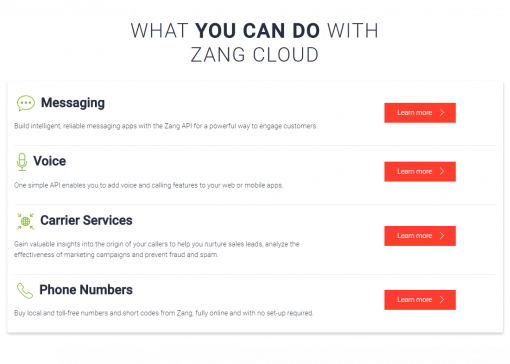Zang Brings Customization to Business Communications Through CPaaS Solution

Communications platform as a service, otherwise known in the industry as CPaas, is a way in which business consumers (specifically a company's developers) can add custom communication features and services into applications and websites via the cloud to enable real-time collaboration. CPaaS allows businesses to leverage Application Program Interfaces (or APIs) in order to create functions that are unique to their business communication needs.
But what really is CPaaS, and how can companies benefit from it? And what does CPaaS bring to the table that could possibly change business communications as we know it? Mohammad Nezarati, the General Manager at Zang, helps us answer these questions and understand more about CPaaS and its function in business communications.
What is CPaaS?
 Communications platform as a service is a cloud-based platform that enables enterprises to embed real-time communication functions into their own applications and workflows. Features like voice, video calling, and SMS, can be integrated into mobile or web-based applications by way of APIs, eliminating the need to build backend infrastructure or interfaces.
Communications platform as a service is a cloud-based platform that enables enterprises to embed real-time communication functions into their own applications and workflows. Features like voice, video calling, and SMS, can be integrated into mobile or web-based applications by way of APIs, eliminating the need to build backend infrastructure or interfaces.
Legacy solutions have not been able to create this kind of seamless integration before, and real-time communications (RTC) were traditionally accessible only in applications built specifically for them.
Advantages of Using CPaaS
Because CPaaS is cloud-based, building and deploying communication features to applications and workflows is simpler, more cost-effective, and easier to maintain. Businesses and their development teams can also save on human resources and infrastructure since CPaaS vendors typically offer software tools, APIs, and other pre-built applications. This allows developers to focus on building their apps instead of worrying about underlying IT infrastructures. Most CPaaS solutions are also available in affordable pay-as-you-go models, helping businesses save cost.
Another benefit of CPaaS is the technical support companies can enjoy. Most providers offer online tutorials, guides, and community forums to help them find answers to their questions. Often they also make access to 24/7 live support available, too.
Creating Customizable Communication Experiences with Zang
Nearly a year ago at the Enterprise Connect conference in Orlando, Avaya unveiled an exciting innovation called Zang. Similar to Cisco’s Tropo, Twilio, Plivo, and Nexmo (acquired by Vonage), Zang is an all-in-one cloud communications-platform-as-a-service (CPaaS) that aims to transform how businesses use communications to reach their customers and employees. Although Avaya wasn’t the first to jump into the CPaaS market, its move fueled the growth of CPaaS.
Introduced in March 2016, Zang was established with a focus on bringing people to the center of communication by offering a set of cloud-based solutions to be delivered as a service. Zang Cloud, its CPaaS solution, is fast becoming one of the top CPaaS platforms today. “Zang primarily helps companies embed communications technology, like email, text, and chat, into your business processes and applications to improve communications and collaboration among internal and external users,” Nezarati said. It caters towards both technical and non-technical people, and from small startups to larger enterprises.
 During Avaya’s Technology Forum 2016 in Dublin, Ireland, Nezarati explained that Zang is about helping businesses, innovators, and developers customize their communications product in a way that best suits their needs. “The idea is that you no longer have to fit the product. We make the product fit you,” he said. And Zang is clearly staying true to their promise. Zang Cloud offers a rich set of features to help businesses build apps tailored to their needs. These include the following:
During Avaya’s Technology Forum 2016 in Dublin, Ireland, Nezarati explained that Zang is about helping businesses, innovators, and developers customize their communications product in a way that best suits their needs. “The idea is that you no longer have to fit the product. We make the product fit you,” he said. And Zang is clearly staying true to their promise. Zang Cloud offers a rich set of features to help businesses build apps tailored to their needs. These include the following:
- Messaging
- Voice
- Call recording
- Call transcription
- Voice changer
- Background audio
- Inbound XML
Although it has only been on the market for less than a year, Nezarati said the platform is already growing rapidly and has seen some very interesting use cases. He listed some interesting examples of Zang-built apps:
- Call-back solutions from Fonolo saves time in the call center for workers and customers alike. Call-backs alleviate contact center workers by reducing call volume, and customers never have to wait on hold.
- OwnerListens streamlines customer service communications. The service enables customers to text businesses, who can then respond quickly and conveniently. The cloud engine analyzes all incoming messages and routes them to the right person, place, system, or chatbot, for an answer, which can be distributed via SMS, email or dashboard.
- Mutare recently released Vital Link, designed to improve hospital patient communications. Through a simple browser interface, clinicians can message with patients or their caregivers after discharge to track their recovery process and intervene before conditions worsen is an evolving best practice.
- TapeACall lets people focus on a call rather than furiously taking notes. It’s one of the most successful call recording apps on the market.
- WhoApp recognizes calls from telemarketers, scammers and even annoying acquaintances you don't want to talk to. It then turns an unknown number into a name, profile picture, address and Google Street View of the location.
One of the bigger and more innovative features that Zang makes available to Zang Cloud users is the drag-and-drop app builder, which gives customers "prebuilt applications and robust APIs so that anyone can use it to leverage the Web’s best offerings to quickly build and deploy applications." “Most of Zang’s competitors require users to write code app ahead of time for applications, but with this app users can run their apps inside of Zang Cloud and do not have to worry about infrastructure for app or the app’s scalability,” Nezarati added.
Beyond CPaaS
Zang offers more than just CPaaS, though. They also offer a real-time collaboration tool, Zang Spaces, and a Unified Communications as a Service (UCaaS) solution, Zang Office.
- Zang Spaces - This solution offers a place to meet through browser/mobile app. According to Nezarati, “Zang has added an element of persistence with Spaces because they realize that meetings don’t end when the call is over. The artifacts of discussion should not be erased.” It integrates voice, video, sharing, and more. Zang has also added a task manager within this meeting space so users can assign tickets, due dates, etc.
- Zang Office - This solution is targeted to small-medium businesses, from 1,000 users and can even be scaled down to 1 user if needed. The concept behind this solution is simple: sign up for service, get a toll free or port your existing number, integrate into the platform, download a softphone, and start making calls in minutes. All features that standard business communications require are already included in the service.
Nezarati said: “What makes Zang unique is that each solution included with Zang is aimed at covering all of the collaboration elements, which makes switching from and between applications easy. Some competitors struggle with this because of disparate systems and separate technology that has been acquired. Overall, Zang wants users to have a seamless experience.” The company also plans on releasing more customer-focused and easy-to-use products in the year ahead.
CPaaS the Next Wave of Unified Communications
With its flexibility, scalability, and high accessibility, CPaaS offers tremendous possibilities for companies who seek to weave communications into their apps and improve their overall business workflows at a low cost. With CPaaS platforms like Zang, now even the smallest startups can be on even footing in terms of innovation and communication with bigger, more established companies today.
About Zang
Zang is the industry’s first all-in-one cloud communications platform and applications-as-a-service. The platform makes it possible for businesses, innovators, and developers to easily add communication functions into their apps without the need to build backend infrastructure or interfaces, enhances their communications experience internally and externally. Zang also offers a host of other solutions including Zang Spaces (a team collaboration and meeting app) and Zang Office (a cloud business phone service). To learn more about Zang, please visit their website.




